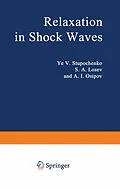1. Experimental Study of Shock-wave Structure.- [1] Creation and Structure of Shock-Waves.- [1] Introduction.- [2] Origin of the Discontinuity in an Ideal Fluid. The Hugoniot Curve.- [3] Dissipative Processes in Shock Waves.- [4] Shock Waves in Multiatomic Gases.- [2] Relaxation Processes in Gases (Elementary Theory).- [1] Establishment of the Maxwellian Distribution.- [2] Excitation of Rotational Degrees of Freedom.- [3] Excitation of Vibrational Degrees of Freedom.- [4] Molecular Dissociation and Ionization.- [5] Sequence of Relaxation Processes in Shock Waves.- [3] Experimental Study of the Shock-wave Structure.- [1] Obtaining the Shock Wave. Simplified Theory of the Shock Tube.- [2] The Quantities Being Measured.- [3] Measuring Methods.- 2. The Shock Tube.- [4] Methods of Obtaining Strong Shock Waves.- [5] Gasdynamic Flows in Shock Tubes.- [6] Inhomogeneity of the Flow Behind the Shock Front.- [1] Inhomogeneity of the Flow Along the Plug.- [2] Multidimensionality of the Flow.- [3] Heat Transfer by Radiation.- [7] Auxiliary Measurements of Flow Variables in Shock Tubes.- [1] Measuring the Shock-wave Velocity.- [2] Measuring the Initial Pressure and Temperature.- [3] Preparing the Test Gas.- 3. Experimental Methods of Study of Nonequilibrium Phenomena in Shock Waves.- [8] General Requirements of the Recording Apparatus.- [9] Certain Relationships for the Flow of Nonequilibrium Gas.- [10] Measuring the Gas Density.- [1] Study of the Reflection of Light from a Shock Front.- [2] The Tepler Shlieren Scheme.- [3] The Interferometer Method.- [4] The Electron Beam Method.- [5] The Use of X-ray Radiation.- [11] Absorption Methods of Molecular Concentration Measurement.- [1] Dependence of the Absorption on the Molecular Concentration.- [2] The Ultraviolet Spectral Region.- [3] Determining the Relaxation Time and Dissociation Rate.- [4] The Visible Spectral Region.- [12] Optical Study of Gases.- [1] Dependence of the Radiation on the Concentration of the Gas Components.- [2] Recording Methods and Some Results.- [3] Temperature Measurement.- [13] Measuring the Electron Concentration.- [1] The Methods of Probes.- [2] Microradiowave Techniques.- [3] The Magnetic Induction Method.- [4] Using the Stark Effect.- [5] Recording the Optical Radiation.- [6] The Interferometer Method.- [14] Other Methods of Measurement.- [1] Thermal Measurements.- [2] Chemical Analysis.- [3] Gasdynamic Experiments.- 4. Relaxation Processes in Shock Waves.- [15] Establishing a Maxwellian Distribution.- [16] Rotational Relaxation.- [17] Vibrational Relaxation.- [1] Kinetic Equations and the Transition Probabilities.- [2] Vibrational Relaxation of Diatomic Molecules which Comprise a Small Admixture in a Monatomic Gas.- [3] Vibrational Relaxation in Pure Gases and in Mixtures with a Monatomic Gas.- [4] Vibrational Relaxation of a Mixture of Polyatomic Gases.- [18] Thermal Dissociation Kinetics.- [1] Thermal Dissociation as Molecular Transition from the Discrete to the Continuous Vibrational State.- [2] Thermal Dissociation in a Single-component System.- [3] Concurrent Consideration of the Thermal Dissociation and Vibrational Relaxation of Diatomic Molecules.- [19] Thermal Ionization Kinetics.- [20] "Nonequilibrium" Radiation of Gases Behind the Front of Strong Shock Waves.- 5. Nonequilibrium Phenomena in Shock Waves in Air.- [21] High-temperature Thermodynamic and Optical Properties of Air.- [22] Vibrational Relaxation.- [23] Chemical Reaction Kinetics.- [24] Thermal Ionization Kinetics and Nonequilibrium Radiation.- 6. Flow of a Gas Undergoing Relaxation.- [25] Introduction.- [26] Equations of Relaxation Gasdyn amies.- [1] Gaskinetic Methods for-Obtaining Equations of Equilibrium and Relaxation Gasdynamics.- [2] The Use of Methods of Thermodynamics of Irreversible Processes.- [27] Certain Properties of the Motion of Fluids Undergoing Relaxation. Transition to Equilibrium Gasdynamics.- [28] The Case of Several Nonequilibrium Parameters.- References.- Author Index.
